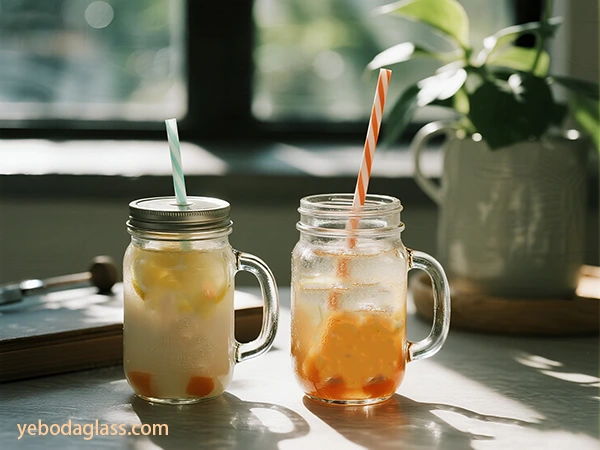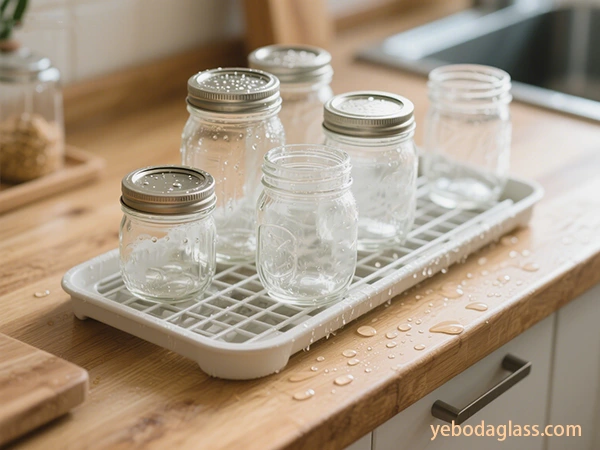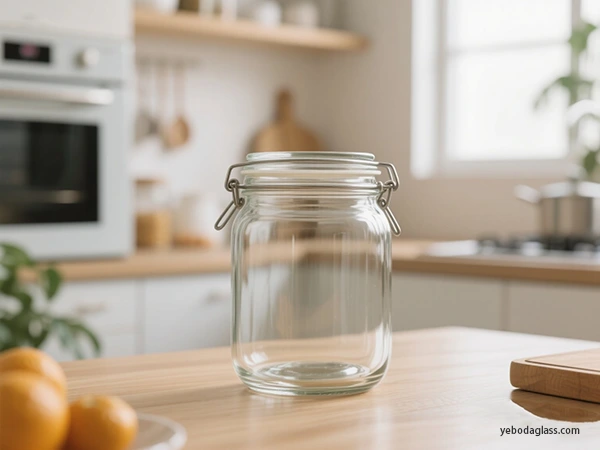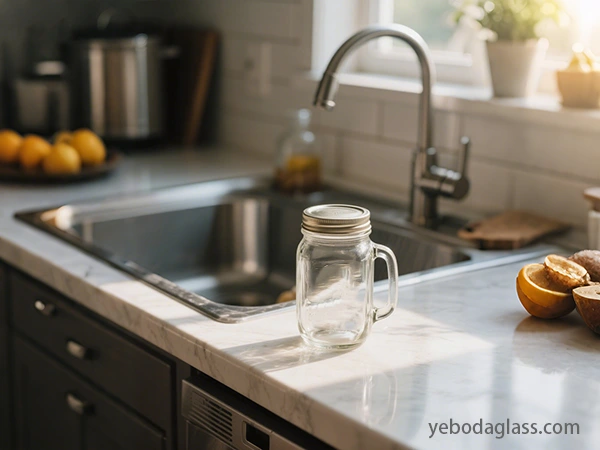Prisidėjimas
Situations where pre-sterilization is not necessary:

As long as the canning is done in a boiling water bath for more than 10 minutes, or in a pressure can, the high temperature during the process is sufficient to sterilize, and there is no need to sterilize the empty cans separately in advance.
Situations where pre-sterilization is necessary:
When a boiling water bath is used to treat highly acidic foods for less than 10 minutes (such as jams and jellies), the empty cans must be sterilized first.
Recommended sterilization method:
Boiling water bath sterilization:
Place clean jars in a boiling water canner, add water to cover the jars by at least 1 inch, and boil for 10 minutes (below 1,000 feet above sea level, boil for 1 minute longer for every 1,000 feet above sea level). Leave the jars in the hot water after sterilization and take them out when you need them to avoid sudden temperature changes.
- Pressure canning (with built-in sterilization function):
- This is a must for low-acid foods! During the process, both the food and the jars will be sterilized at the same time. The specific steps should be based on reliable recipes (such as the USDA canning guide).
- Note: The sterilization mode of the dishwasher is not thorough enough, and oven sterilization is even more dangerous (it is easy to cause the jars to explode due to uneven heating). Neither is recommended!
Detailed steps: Follow the steps to sterilize properly
Boiling water bath sterilization
Detailed steps: Follow the steps to sterilize properly
Pressure canning
Just wash the jars, no need to sterilize in advance, keep them warm (put them in hot water or a warm oven).
Put hot food in, leave a suitable head space, wipe the jar mouth, put a new lid, and gently tighten the screw cap. Place the jars in the pressure canner, add the specified amount of water, cover but not pressurize, and heat to exhaust for 10 minutes. Pressurize to the specified poundage (adjusted according to altitude) according to the recipe, keep the pressure stable, and process for the specified time. Turn off the heat after processing, let the pressure canner cool naturally to zero, then open the lid to take out the jars and put them in a clean place to cool.
Keep it sterile: This is the right thing to do after sterilization
Now that you have learned how to sterilize mason jars, don’t let the last step ruin things! How you handle and store the sterilized jars is directly related to whether they will be contaminated with bacteria again, especially when you need to sterilize them in advance, you must be careless.
Use it while it's hot, don't wait for it to cool down
The most important point is to use the sterilized jars that have just been taken out of boiling water, the oven or the dishwasher! This is emphasized by all methods and can avoid bacteria to the greatest extent.
More than 1 hour? Re-sterilize
If you really can’t use it immediately, don’t exceed 1 hour at most. Whether it is a jar, lid or screw cap, you have to sterilize it again after 1 hour; you can also soak the jar in hot water for temporary storage, but it can’t exceed 1 hour.
Maintain temperature to prevent cracking and bacteria

Keep the jar warm before filling it, which can not only prevent cracking due to the large temperature difference when pouring hot food, but also help maintain a sterile environment. Either leave it in the sterilized hot water or put it in the oven at the lowest temperature to keep it warm, and take it out when you are ready to fill it.
Don't make these small moves
- Remember to wear gloves or use jar clips when handling hot jars, and put them on a clean towel or cooling rack, not directly on a cold countertop (it is easy to crack). Also! After sterilization, never touch the inside of the jar and the sealing surface of the lid! These situations attract bacteria
- The surrounding environment is dirty, the jar is placed on a dirty rag, bacteria may take the opportunity to sneak in; after the jar is cooled, there are water droplets, which is a “nest” for bacteria. Safety Tips & Canning Best Practices
When sterilizing mason jars (aka how to sterilize mason jars) and canning, these details are directly related to food safety, so remember them!
- Don't change the recipe, follow the "standard answer" Canning safety depends on scientifically proven recipes – it will clearly state whether to use a boiling water bath or pressure canning, how long to cook, and how much pressure (if necessary). Especially for low-acid foods, don’t add untried ingredients such as butter, flour, and rice, which will affect the heating effect and may make the food dangerous.
- Dedicated jars are reliable Always use mason jars and tools specifically for home canning! “Part-time” containers such as mayonnaise bottles and salad dressing bottles will not work. They can’t withstand the high temperature and pressure during canning, are easy to crack, and may not seal well.
Check the lid of the jar first
Check the jar carefully for cracks and gaps before each use; it is best to use a new metal lid (disposable ones are safer) and choose the model that meets the manufacturer’s recommendations; although the screw cap can be reused, throw away the rusted and deformed ones immediately.
There are some particularities in the lid treatment
The current metal lid does not need to be boiled, just wash it clean; the same is true for the screw cap, wash it and check it before using it.
Use the jar while it is hot to prevent cracking and sanitation
Before filling hot food, keep the jar warm (such as placing it in sterilized hot water or keeping it warm in the oven at low temperature) to avoid sudden cracking due to heat, and it can also help maintain a sterile environment.
Wipe the jar mouth clean to seal it tightly
After filling the food, be sure to wipe the jar mouth clean so that the lid can be sealed tightly and not easily damaged.
The pressure canning must be exhausted thoroughly
When using a pressure canner, exhaust the air according to the instructions, so that the required temperature can be reached and the sterilization can be more thorough.
Is the altitude high? The time pressure needs to be adjusted
The boiling point of water is different at different altitudes. If you live at a high altitude, the boiling water bath time or the pressure of the pressure canner must be adjusted accordingly, otherwise the sterilization will not be thorough.
Be careful when handling hot jars, and don't burn your hands
Use jar clips or oven gloves to take hot jars, be steady, don’t drop them or burn them.
Check the seal after cooling
After canning, put them in a ventilated place to cool naturally, and then check the lid – if the center is concave and it sounds crisp when knocked, it is sealed; if it is not sealed, put it in the refrigerator quickly, or re-make it.
The safest storage environment is cool and dry
Sealed canned food should be placed in a cool, dry, dark place, and the temperature should be between 10°C and 21°C. Don’t let it be exposed to the sun, and don’t let it fluctuate between hot and cold, so that it can be stored for a long time and eaten with confidence.
If you want to know how to sterilize mason jars and preserve food at home, it is very important to choose the right jar! From distinguishing the difference between sterilization and sterilization, to choosing boiling water bath or pressure canning according to the ingredients, to careful cleaning and inspection – every step cannot be vague. Follow the guidelines of authoritative organizations such as USDA and NCHFP, and avoid unreliable methods such as oven sterilization, so that canned food can be eaten with confidence.

And YEBODA Mason jars are your reliable partner:
Good glass, safer: food-grade lead-free glass, specially tempered, heat-resistant and pressure-resistant, can withstand boiling water bath and pressure canning, not easy to crack, and reliable to use.
Accurate size, stable sealing: The size and thread of the jar mouth strictly meet the standards, perfectly match various lids and screw caps, and the sealing is super reliable, which is the key to long-term food preservation.
Durable and environmentally friendly: With good cleaning and maintenance, it can be used repeatedly for several years, saving money and environmentally friendly.
It has many uses and is very practical: it can not only can be used for canning, but also for storing dry goods, fermenting, refrigerating food, mixing drinks, and even as decoration. It can be used in various scenes at home.
Choosing YEBODA Mason jars means choosing safety, reliability and high quality. We know that you value your family’s peace of mind, so we make every jar carefully, so that you can have confidence every time you can can and enjoy the joy of homemade food. From cleaning, disinfection to storage, it is a good helper that you can’t do without in the kitchen!
Pirmiausia patikrinkite krepšelį
Kiekvieno naudojimo prieš patikrinkite krepšelį dėmėmis ir tarpais; geriausia naudoti naują metalinį krepšelį (vienkartinės yra saugesnės) ir pasirinkti modelį, atitinkantį gamintojo rekomendacijas; nors virveles galima naudoti kartą, atmetkite rūko ir deformuotas.
Krepšelio apdorojimas turi savo specyfika
Šiandieniniam metaliniam krepšeliui nereikia šaldyti, tik šiai peršauti; taip pat yra ir virvele – peršauti ir patikrinti prieš naudojimą.
Naudojamas krepšelį šiltesnis, kad išvengtumėte dėmėjimo ir apsaugo jį
Prieš užpildant karštą maistą, laikykite krepšelį karštą (pvz., įdėdami į sterilizuotas karštą vandenį ar laikant žemesne temperatūroje ugniai) kad išvengtumėte šilumos dėžmės ir pagalbų išlaikyti sterilių aplinkybes.
Iššalinėkite krepšelio galą, kad būtų uždengtas tvirtai
Užpildę maistą, tinkamai iššalinėkite krepšelio galą, kad krepšelis galėtų tvirtai uždengti ir ne lengvai pažeistis.
Spaudžiamo kveikimo turi pilnai išvengti
Naudojant spaudžiamąjį kveikimą, pagal instrukcijas išspalvinkite oro, kad pasiekiamas reikalingas temperatūra ir pastovumas būtų daugiau.
Aukštis aukštas? Spaudžiamo kveikimo laikas turi būti pakoreguotas
Vandens virimo temperatūra skiriasi skirtingose aukštumoje. Jei gyvenate aukštumoje, šaldymo laikas arba spaudžiamo kveikimo spaudimas turi būti pakoreguotas atitinkamai, kitu atveju pastovumas nebūtų pakankamas.
Laikykite dėmesį kadaugodamasi šiltesnių krepšelių, kad niekada nepažeistumėte rankų
Panaudokite krepšelio rėmą ar kepurėlę, kad perimėtumėte šiltesnius krepšelius, būkite pastangūs, kad niekada nepadėžiate ar niekada nepažeistumėte.
Patikrinkite uždangą po šaltinėjimo
Šaldant, palikite jį praleidžiant natūraliai šalti, vėliau patikrinkite krepšelį – jei vidurys būna išbėgęs ir kai krintant girdėjama skardžio garsas, tai uždengtas; jei nėra uždengtas, greitai palikite冰箱, arba pakartokite.
Saugiausias saukos aplinka yra šalta ir drėgna
Uždengtų šaldytų maisto produktų turi būti paliktos šaltame, drėgnoje, tamsioje vietoje, temperatūra turi būti tarp 10°C ir 21°C. Neletykite jį būti saulėje, ir neletykite pernašykite tarp šilto ir šaltumo, kad galėtumėte ilgai saugoti ir patikimai vartoti.

viršelis
Jei norite žinoti, kaip šaldyti mason krepšelius ir saugoti maistą namuose, tai svarbu pasirinkti tinkamą krepšelį! nuo sterilizacijos ir pastovumo skirtumo, iki pagal sudėtį pasirinkimo šaldymo arba spaudžiamo kveikimo, iki dėmėjimo ir inspekcijos – kiekvienas žingsnis negali būti vėluotas. Sisiekite pagal autoritetingų organizacijų, kaip USDA ir NCHFP, rekomendacijas, ir išvengkite nepastovų metodų, kaip ugnioje sterilizacija, kad šaldytas maistas būtų patikimas.
Ir YEBODA mason krepšeliai yra jūsų patikimas draugas:
- Geras stiklas, saugesnis: maisto kokybės be olo stiklas, specialiai apdorojamas, šilumos ir spaudimo išlaikantis, gali išlaikyti šaldymą ir spaudžiamąjį kveikimą, lengvai nėra dėmėjamas, ir patikimas naudojimas.
- Tinkamas dydis, stabilus uždangas: krepšelio galo dydis ir grandys striktingai atitinka standartus, tiksliai derinasi su įvairiais krepšeliais ir virvele, ir uždangas yra labai patikimas, tai yra pagrindas ilgalaikiam maisto saugojimui.
- Suvartomas ir ekologinis: Po gerų dėmėjimo ir apdorojimo, jis gali būti naudojamas keletą metų, išlaiko pinigus ir yra ekologinis.
- Jis turi daug naudojimų ir yra labai praktiškas: gali naudoti ne tik šaldymui, bet ir drėgnųjų prekių saugojimui, fermentavimui, ledų laikymui, gėrimų derinimui, net ir kaip dekoracija. Gali būti naudojamas įvairiose namų scenose.
Pasirinkdami YEBODA mason krepšelius, pasirinkote saugumą, patikimumą ir aukštų kokybę. Manom, kad jūsų šeimai svarbu paslaugingumas, todėl kiekvienas krepšelis yra daromas atidėmę, kad jūsų galėtumėte patikimumą kiekvieną kartą šaldykite ir malavosimėte namų maisto malonę. nuo dėmėjimo,消毒 iki saugojimo, tai yra kovos, kurią negalima be kiekvienam darbo žmogui!

